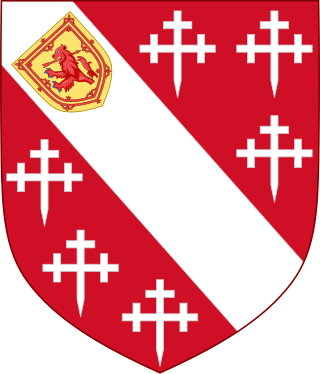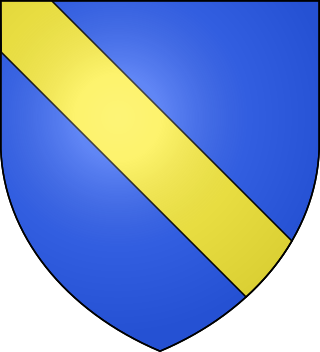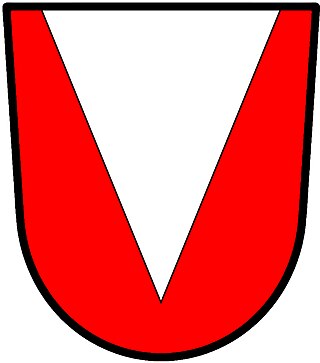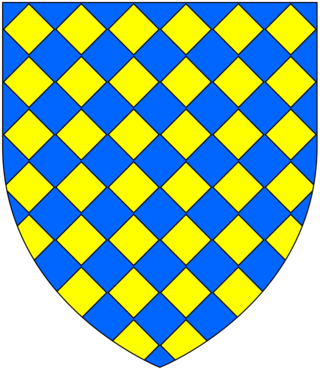Heraldic case
In 1385, Richard II led his army on a punitive expedition to Scotland. During the military campaign, two of the king's knights, Richard Scrope, 1st Baron Scrope of Bolton, from Bolton in Yorkshire, and Sir Robert Grosvenor from Cheshire, both realised they were using the same coat of arms, blazoned Azure, a bend Or . When Scrope brought an action, Grosvenor maintained his family had worn these arms since his ancestor had come to England with William the Conqueror in 1066.
The case was brought before the Court of Chivalry and presided over by Thomas of Woodstock, 1st Duke of Gloucester, the Constable of England. Several hundred witnesses were heard, including John of Gaunt, Duke of Lancaster, [1] : 163 Geoffrey Chaucer, himself a close friend of the Duke of Lancaster and a sometime member of his court; [1] : 404 and a then little-known Welshman called Owain Glyndŵr, who gave his evidence with others at the Church of St John the Baptist in Chester on 3 September 1386. [2]
It was not until 1389 that the case was finally decided in Scrope's favor. Grosvenor was allowed to continue bearing the arms but they had to be within a bordure argent for difference.
Neither party was happy with the decision so King Richard II was called upon to give his personal verdict. On 27 May 1390 he confirmed that Grosvenor could not bear the undifferenced arms. His opinion was that the two shields were far too similar for unrelated families in the same country to bear.

Heraldry is a discipline relating to the design, display and study of armorial bearings, as well as related disciplines, such as vexillology, together with the study of ceremony, rank and pedigree. Armory, the best-known branch of heraldry, concerns the design and transmission of the heraldic achievement. The achievement, or armorial bearings usually includes a coat of arms on a shield, helmet and crest, together with any accompanying devices, such as supporters, badges, heraldic banners and mottoes.

His Majesty's High Court of Chivalry is a civil law court in English and Welsh law with jurisdiction over matters of heraldry. The court has been in existence since the fourteenth century; however, it rarely sits. The sole judge is now the hereditary Earl Marshal of England, the Duke of Norfolk, though if not a professional lawyer, he normally appoints a professional lawyer as his lieutenant or surrogate.

In heraldry, variations of the field are any of a number of ways that a field may be covered with a pattern, rather than a flat tincture or a simple division of the field.

The Howard family is an English noble family founded by John Howard, who was created Duke of Norfolk by King Richard III of England in 1483. However, John was also the eldest grandson of the 1st Duke of the first creation. The Howards have been part of the peerage since the 15th century and remain both the Premier Dukes and Earls of the Realm in the Peerage of England, acting as Earl Marshal of England. After the English Reformation, many Howards remained steadfast in their Catholic faith as the most high-profile recusant family; two members, Philip Howard, 13th Earl of Arundel, and William Howard, 1st Viscount Stafford, are regarded as martyrs: a saint and a blessed respectively.

Hugh Richard Arthur Grosvenor, 2nd Duke of Westminster, was a British landowner and one of the wealthiest men in the world.

In heraldry and heraldic vexillology, a blazon is a formal description of a coat of arms, flag or similar emblem, from which the reader can reconstruct the appropriate image. The verb to blazon means to create such a description. The visual depiction of a coat of arms or flag has traditionally had considerable latitude in design, but a verbal blazon specifies the essentially distinctive elements. A coat of arms or flag is therefore primarily defined not by a picture but rather by the wording of its blazon. Blazon is also the specialized language in which a blazon is written, and, as a verb, the act of writing such a description. Blazonry is the art, craft or practice of creating a blazon. The language employed in blazonry has its own vocabulary, grammar and syntax, which becomes essential for comprehension when blazoning a complex coat of arms.
Robert Puleston was a brother-in-law and supporter of Owain Glyndŵr, at the time of his rebellion against King Henry IV of England in the early 15th century and afterwards.

Richard le Scrope, 1st Baron Scrope of Bolton was an English soldier and courtier, serving Richard II of England. He also fought under the Black Prince at the Battle of Crecy in 1346.

Attributed arms are Western European coats of arms given retrospectively to persons real or fictitious who died before the start of the age of heraldry in the latter half of the 12th century. Once coats of arms were the established fashion of the ruling class, society expected a king to be armigerous. Arms were assigned to the knights of the Round Table, and then to biblical figures, to Roman and Greek heroes, and to kings and popes who had not historically borne arms. Each author could attribute different arms for the same person, but the arms for major figures soon became fixed.

In heraldry, a pile is a charge usually counted as one of the ordinaries. It consists of a wedge emerging from the upper edge of the shield and converging to a point near the base. If it touches the base, it is blazoned throughout.

English heraldry is the form of coats of arms and other heraldic bearings and insignia used in England. It lies within the so-called Gallo-British tradition. Coats of arms in England are regulated and granted to individuals by the English kings of arms of the College of Arms. An individual's arms may also be borne 'by courtesy' by members of the holder's nuclear family, subject to a system of cadency marks, to differentiate those displays from the arms of the original holder. The English heraldic style is exemplified in the arms of British royalty, and is reflected in the civic arms of cities and towns, as well as the noble arms of individuals in England. Royal orders in England, such as the Order of the Garter, also maintain notable heraldic bearings.
Cornish heraldry is the form of coats of arms and other heraldic bearings and insignia used in Cornwall, United Kingdom. While similar to English, Scottish and Welsh heraldry, Cornish heraldry has its own distinctive features. Cornish heraldry typically makes use of the tinctures sable (black) and or (gold), and also uses certain creatures like Cornish choughs. It also uses the Cornish language extensively for mottoes and canting arms.

The Gorges family was a gentry family established in the southwest of England.
Carminow is an Anglo-Cornish surname, sometimes spelled Carminowe

Warbelton v. Gorges was one of the earliest heraldic law cases brought concerning English armory, in 1347. It concerned the coat of arms blazoned Lozengy Or and azure, that is a field of yellow and blue lozenges. The arms were borne by the unrelated families of Warbelton, from Hampshire, and Gorges, from Somerset, apparently without knowledge of each other or their common usage, until John de Warbelton and Theobald de Gorges served together in the English army at the Siege of Calais in 1346/7. A gentleman's armorial bearings represented his very identity and were of enormous importance to him, both as a matter of family pride and for practical purposes of personal recognition in battle and in legal seals. Warbelton made a formal complaint to the officer appointed by the king to resolve such matters, namely Henry of Grosmont, Earl of Lancaster, seneschal of England, who was commanding the English forces. A 6-man court of honour was convened and the pair were cross-examined, with evidence being sought from knights of their own localities also serving at the siege.

Sir John Sully, KG, of Ruxford and Iddesleigh in Devonshire, was an English knight. He was one of the many deponents who gave evidence in Scrope v Grosvenor, one of the earliest heraldic law cases brought in England, at which time he stated his age as 105. In about 1362, he was appointed by King Edward III as the 39th Knight of the Garter.
Ancient and modern are terms used in heraldry to differentiate two different coats of arms used at different periods by a family or other bearer. Reasons for changing arms have been numerous, the most famous being the 1376 change in the French royal arms by Charles V of France to show three fleurs-de-lis instead of semee de lis, possibly to symbolize the Holy Trinity. The reasons for other changes were more prosaic, for example where a court of chivalry ordered a change or differencing where two families claimed the same arms, as in the famous case of Scrope v Grosvenor. The resulting two versions of arms are referred to as "France ancient" and "France modern", "Grosvenor ancient" and "Grosvenor modern".

Heraldry is the system of visual identification of rank and pedigree which developed in the European High Middle Ages, closely associated with the courtly culture of chivalry, Latin Christianity, the Crusades, feudal aristocracy, and monarchy of the time. Heraldic tradition fully developed in the 13th century, and it flourished and developed further during the Late Middle Ages and the Early Modern period. Originally limited to nobility, heraldry is adopted by wealthy commoners in the Late Middle Ages. Specific traditions of Ecclesiastical heraldry also develop in the late medieval period. Coats of arms of noble families, often after their extinction, becomes attached to the territories they used to own, giving rise to municipal coats of arms by the 16th century.

Hugh Hastings III, Lord of Elsing, Brisley and Grimston, was an English soldier and noble who fought in the Hundred Years' War.

Grey v Hastings (1410) was a heraldic law of arms case brought in England. The case resulted from two different families found using the same undifferenced coat of arms.
















